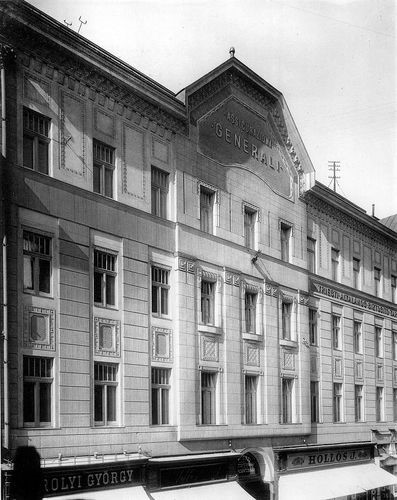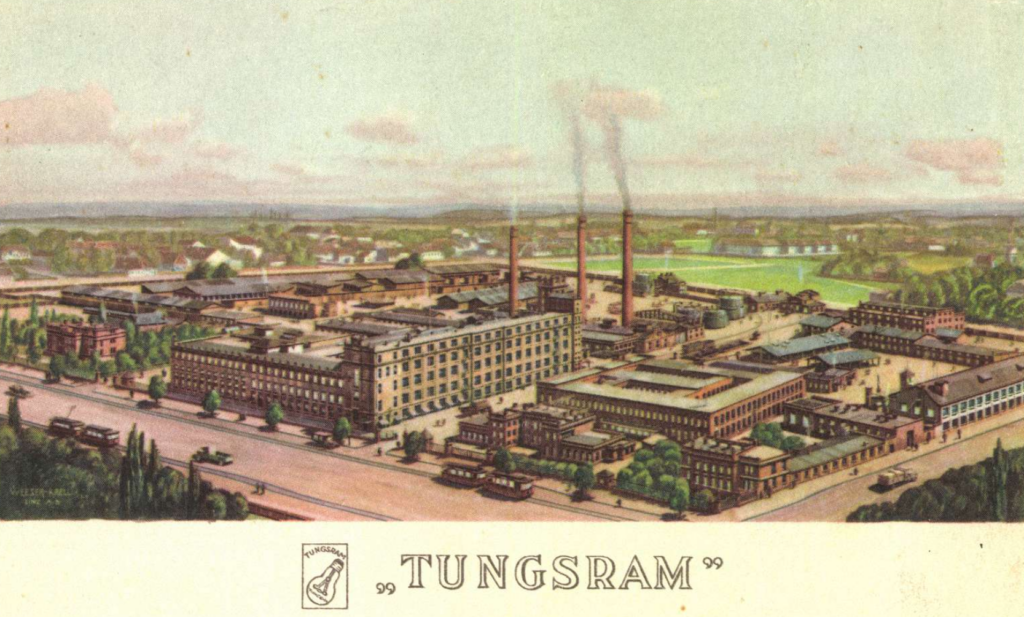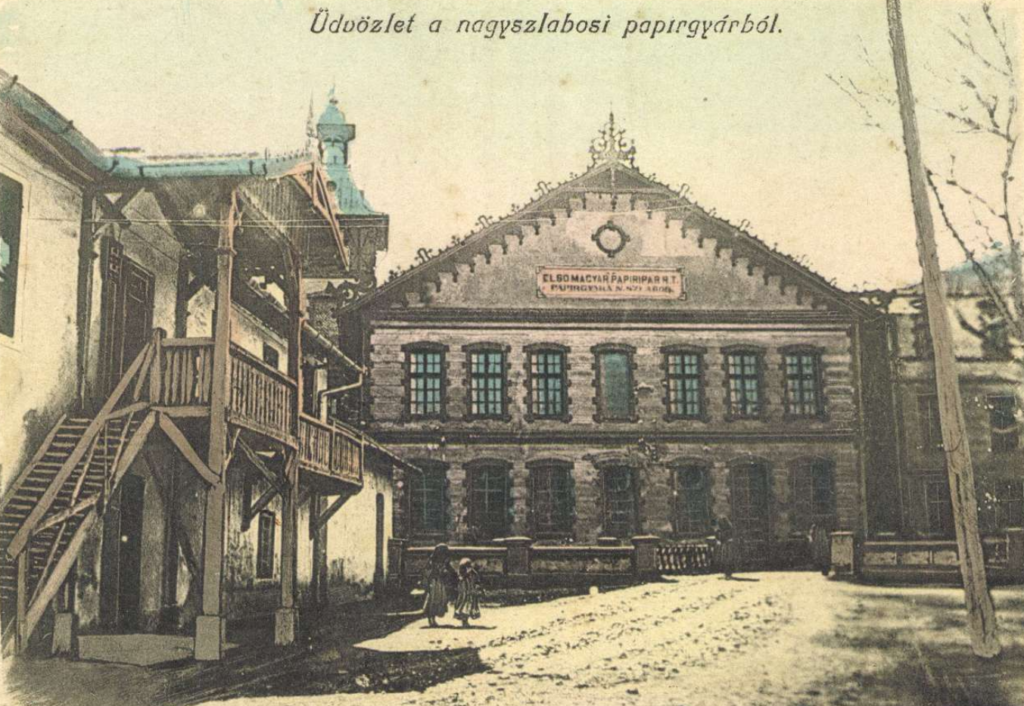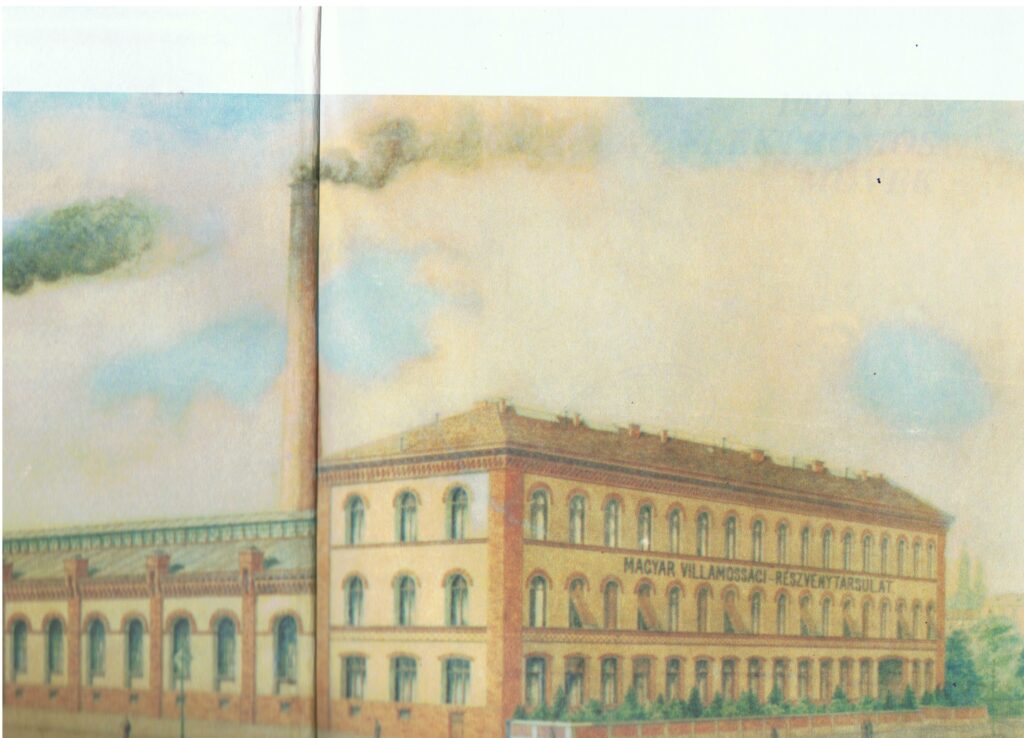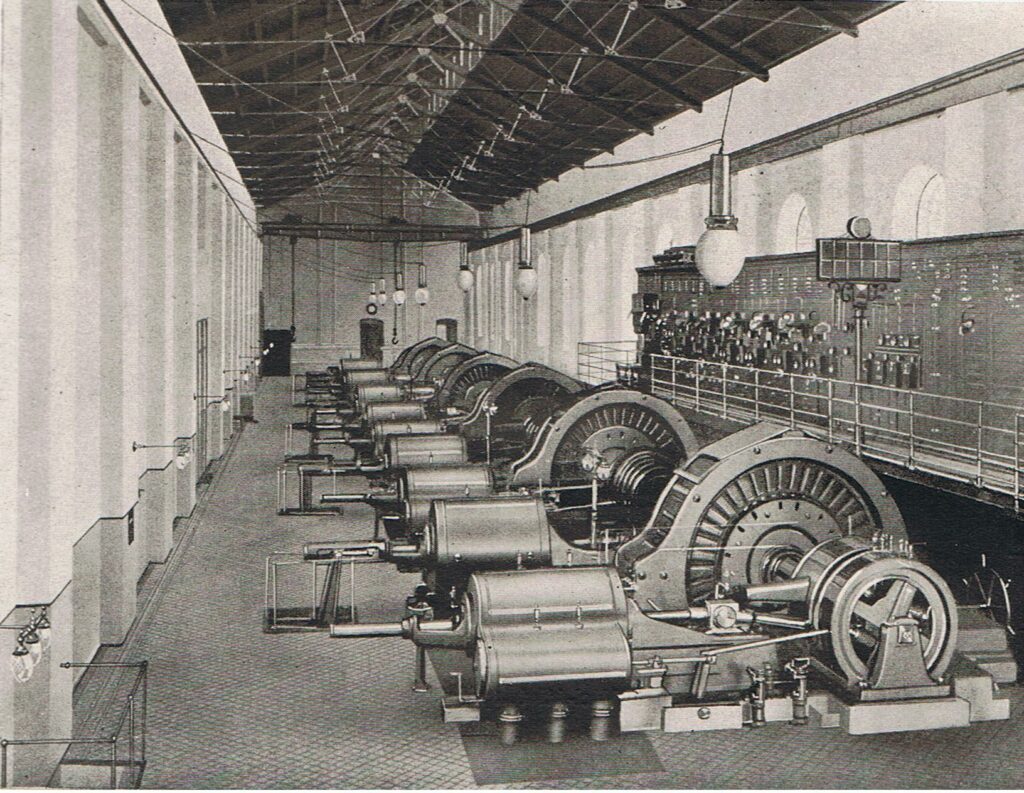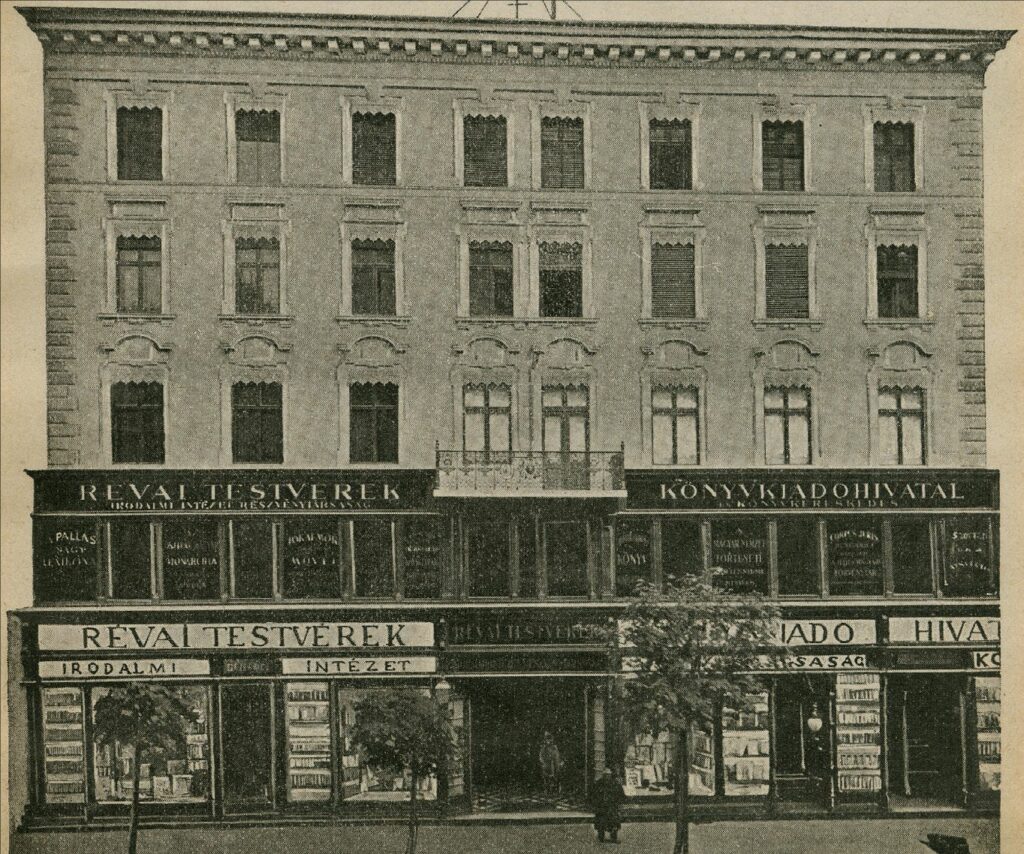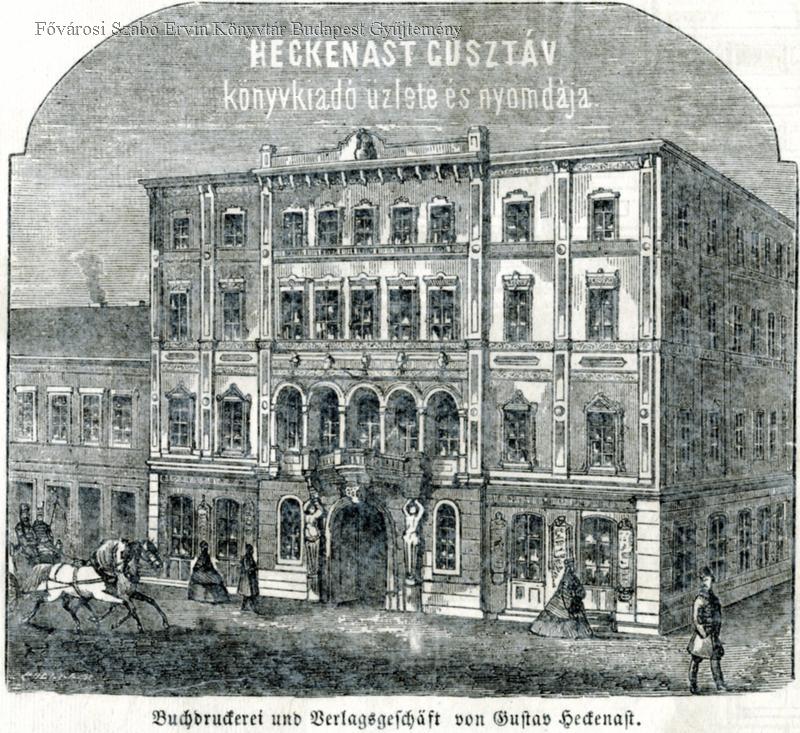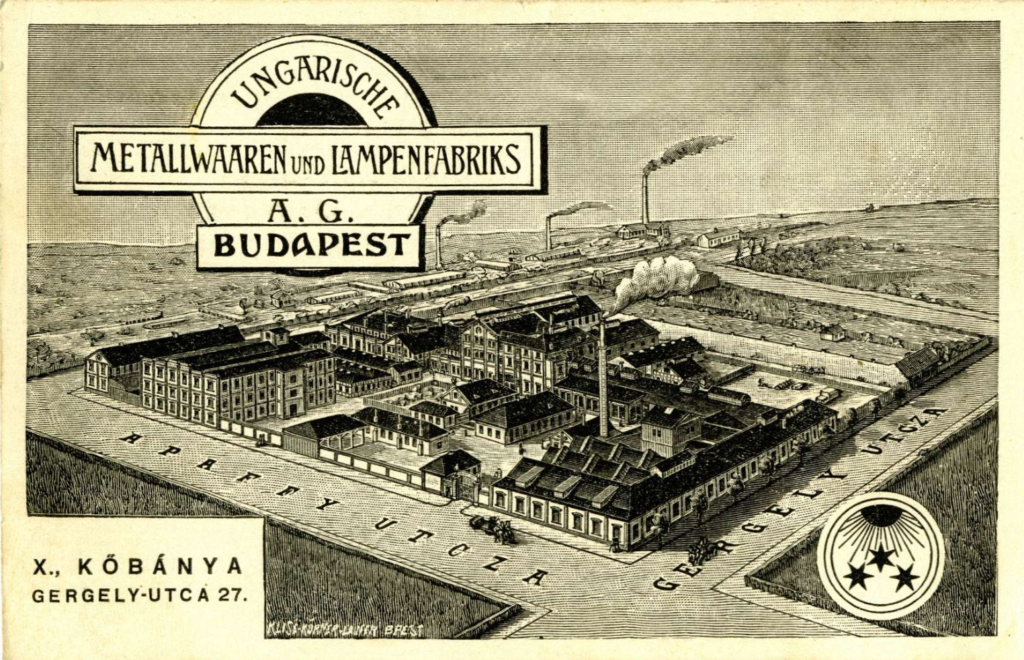History of famous companies
"Adria" Royal Hungarian Sea Navigation Company Limited
Adria Plc. was the largest Hungarian commercial shipping company ever. It was founded in a succession of events between 1874 and 1882, after which it operated uninterrupted until the First World War. Its main activity was long-distance shipping from Rijeka to Western Europe and beyond.
"Athenaeum" literary and printing ltd
Athenaeum Publishing House is one of the largest publishing houses in Hungary.From its foundation in 1841 until 1948, it published the works of the most important writers and poets of the time and thus played a decisive role in Hungarian literature. From 1948 until 1998 it operated exclusively as a printing house, since then it has been publishing books on a limited scale, but is now also publishing again.
"Fonciére" general insurance institute
Foncière, or its predecessor Pesti Biztosító, was one of the most important insurance companies in Hungary for eight decades from its foundation in 1864 until its nationalisation in 1948, and a market leader from the 1930s.
"István" brickworks ltd
The "István" Brickworks Joint Stock Company was founded by the Belvárosi Takarékpénztár Joint Stock Company in 1892, when it took over the already existing brickworks in Banaharco. Ferenc Székely became chairman of the company in 1902, a position he held until 1926. Due to the variable production results and the difficulties following the First World War, the company was forced to merge with Újlaki [...]
"Pallas" literary and printing ltd
The Pallas Literary and Printing Company was founded on 5 April 1884 and soon became one of the best-known printing houses in the country. Almost all the important scientific and public publications of the turn of the 19th and 20th centuries were published by the most important printing houses in Hungary, including Pallas.
"Szikra" Hungarian match factories ltd
In 1915, the Austrian Solo group acquired significant interests in the Hungarian match factories, creating Szikra Hungarian Ignition Factories Ltd. The new group of companies, under the authority of the Anglo-Hungarian Bank, started technological developments which led to the bankruptcy of several smaller match factories. It was at this time that the safety match technology from Jönköping in Sweden was introduced into domestic production. The company became a monopoly in 1928 and operated until its nationalisation in 1949.
"Danubius" Hungarian ship and machinery factory ltd
The Ganz-Danubius shipyard, created by a merger in 1911, was one of the top companies in industrial production at the end of the dualism. The joint-stock company focused primarily on shipbuilding at this time, but was also active in a number of other industries. In terms of both predecessors and successors, the company is the result of an extremely exciting and complex organisational development.
General wagon hire association
With the boom in rail traffic, the Empire's railway companies could not always meet all the needs with the means at their disposal, and the market was opened up to wagon hire companies. The first company of this profile in Hungary was founded in 1872. By the end of the 19th century, with the development of the railway network, the recapitalisation of railway companies and the strong carriage and wheel production of the Hungarian industry, wagon hire became a shrinking industry, and in 1906 General Waggon Rental was merged into the Hungarian Local Interest Railways Joint Stock Company and thus ceased to exist.
Bauxit Trust A.-G., Zurich
Due to the economic and political difficulties following the First World War, the company Bauxit Trust A.-G. was founded in 1923 by a Zurich banking company and the Hungarian Aluminium Ore Mining and Industry Corporation. Already in the first decade of its operation, the company acquired significant quantities of shares from other companies, and in 1925 it concluded a favourable contract with German companies affiliated to it for the exploitation of bauxite in Hungary. The company was able to increase its profits significantly in the 1930s and continued to explore for bauxite deposits until the end of the Second World War.
Vienna Insurance Company
The Vienna Insurance Company is a joint foundation of the First Hungarian General Insurance Company (EMÁBIT) and Viennese business circles. Initially it was engaged in elementary and cargo insurance, later it was extended to accident and motor insurance. In principle, its area of operation covered the provinces of the Habsburg Monarchy beyond the Lusatian border, but in practice it also sold insurance extensively in Hungary, relying on EMÁBIT's infrastructure and network of agents. After the dissolution of the Monarchy in 1925, the company was merged into Phőnix Biztosító, also based in Vienna.
Vienna Life and Annuity Insurance Institute
The Vienna Life and Annuity Insurance Institute is a joint foundation of the First Hungarian General Insurance Company (EMÁBIT) and the Vienna Insurance Company Vienna. It can be regarded as a twin company of the Vienna Insurance Company, which, under the new regulations introduced in the mid-1870s, was exclusively engaged in life and annuity insurance, separate from the elementary insurer. In principle, it operated in the provinces of the Habsburg Monarchy beyond the Lusatian border, but in practice it also sold insurance extensively in Hungary, relying on the infrastructure and agent network of EMÁBIT. After the dissolution of the Monarchy in 1925, the company was merged into Phőnix Life Insurance Company, also based in Vienna.
Beocsin cement factory union ltd
The Beocsin Cement Factory Unio Rt. was established in 1906 by the merger of several previously existing and operating cement factories by the Hungarian General Credit Bank (MÁH). The first company in cement production in Hungary was the plant in Ftatlan, which was the same time as the Beocsin cement factory was established in 1869. They were followed by the Nyergesújfalu plant in 1870 and the Óbuda-újlak cement factory in 1880. The whole industry [...]
Borsod coal mines ltd
The Borsodi Coal Mines Joint Stock Company started its operations in 1910. The company was originally established for lignite mining, but from 1923 it also produced electricity. During the war, it significantly increased its coal mining activities, and from the 1920s the company's power station supplied electricity to the surrounding villages and industrial plants. Its importance continued into the second half of the 1930s.
Brassó cellulose factory ltd
The Brasov Cellulose Factory Joint Stock Company was founded in 1889. In the first decades it was a subsidiary of the Hungarian General Credit Bank. In the 1920s, it took an interest in the management of several other factories. The world economic crisis had a significant impact on the operation of the joint-stock company: it sold almost all its interests in the 1930s, as prices fell due to overproduction and export opportunities became more limited.
Budapest-Szentlőrinc and Tata Tile and brick factory
911 The Budapest-Szentlőrinc and Tatai Cserép- és Tátai Cserép- és Bréglagyár Részvénytársaság was founded in 1889 by the Hungarian General Credit Bank. The establishment of the factory and the conditions for brick production were favoured by the construction of the local railway connecting the factory with the capital. The improvements made in the 1910s enabled the company to maintain its importance between the two world wars, although the 1930s [...]
Budapest Tunnel Society
A joint-stock company led by István Széchenyi was formed in the 1840s to build the tunnel at várhegy, but this company was unable to start work. A new company was formed in 1850, and the tunnel was completed by 1857. The joint-stock company was granted the right to charge a fee for the crossing for 50 years, this right expired in 1907, after which the state took over the operation of the tunnel.
Budapest general electricity ltd
The Budapest General Electricity Joint Stock Company was founded in 1892 with a share capital of 3 million crowns. Under an agreement with the capital, the company produced alternating current and direct current electricity, but only direct current electricity could be sold on the market.
Budapest Banking Association ltd
The Budapest Banking Association was one of the typical financial institutions of 19th century Budapest. Although it was basically set up to finance the small businesses of artisans and craftsmen, the bank's predecessor organisations had lived through the stock market crisis of 1873, participated in dubious transactions that took advantage of Budapest's development, and sometimes even embezzled.
Sugar factory ltd Veliki-Beckerek
Nagybecskerek Cukorgyár Részvénytársaság (between 1910 and 1920 Délmagyarországi Cukoripar Részvénytársaság, from 1920 Veliki Bečkerek Cukorgyár Részvénytársaság) was a sugar factory that existed since 1910, and after 1920, under the Treaty of Trianon, it was abroad, but always under the ownership of the Hungarian Calculation and Exchange Bank. The company was founded by Count Sándor Csekonics, who was its chairman from the very beginning. The main activity of the factory was the production of raw and refined sugar, which was highly successful among other sugar factories in Yugoslavia.
Danubius-Schoenichen-Hartmann United Ship, Machine and Boiler Works Ltd
The Ganz-Danubius shipyard, created by a merger in 1911, was one of the top companies in industrial production at the end of the dualism. The joint-stock company focused primarily on shipbuilding at this time, but was also active in a number of other industries. In terms of both predecessors and successors, the company was the result of an extremely exciting and complex organisational development, of which one was a Danubius-Schoenichen-Hartmann yard.
Diana industrial and commercial ltd
Diana Trade and Industry Ltd. was the company that produced and sold Diana's salt and vinegar-based sugar and other confectionery and cosmetic products between 1914 and 1948.
United Incandescent and Electric Ltd.
The United Incandescent and Electric Light Company was founded in 1896. Its famous manufacturing plant was built in Újpest in 1900, where production of the widely popular tungsten filament filament lamp began in 1907. The development of the company in the first half of the 1910s made it a large corporation, and its steady growth was only marginally affected by the First World War and the Great Depression. After the reconstruction work following the Second World War, the public limited company maintained its reputation during the socialist era.
United brick and cement factory ltd
The United Cement and Brickworks Joint Stock Company was founded in 1892 by the Hungarian General Credit Bank. As a result of the boom in the 1890s, the company acquired further factories, and in 1903 it absorbed another joint-stock company. At the beginning of the 1910s, the company participated in the construction of the first cement factory in Hungary to use the most modern techniques in the industrial process [...]
First Gyula steam mill Reisner Ede ltd
The First Gyulai Steam Mill Reisner Ede Reisner Joint Stock Company was founded in September 1917, the company's activities were "the acquisition of the company's steam mill in Gyula, the continuation of the mill business, as well as the purchase and sale of grain and other agricultural products, the production, processing and marketing of grist for own account and for the account of third parties". The company was listed on the stock exchange from 1924 to 1926. In 1929, during the Great Depression, the company went into crisis and became indebted, which led to its liquidation in 1935.
First Hungarian General Assurance Company
The First Hungarian General Insurance Company was the most important insurance company in Hungary for nine decades, from its foundation in 1857 until its nationalisation in 1948. As a general insurer, it was engaged in all branches of elementary insurance as well as life insurance. The company became a market leader immediately after its foundation and later established several subsidiaries. It led the consolidation of the insurance sector after the First World War and between the two world wars was the chairman of the National Association of Insurance Institutes, the cartel organisation of insurers.
First Hungarian wool laundry and fine textile mill ltd
The First Hungarian Wool Washing and Donation Company was founded in 1868 by the Pesti Hazai Taka-Rékpénztár and some large landowners. The company, which has been listed on the stock exchange since 1872, distinguished itself in the first decade of its operation with its finished products (potash, cotton wool), to such an extent that the former wool laundry company specialised in post-grass production from 1920. This led to the company's name change, from 1929 to First Hungarian Wool Washer and Finisher Company Limited. The company, chaired by Baron Adolf Kohner, was set back by the Second World War and was nationalised in 1948.
First Hungarian paper industry ltd
The First Hungarian Paper Mill Joint Stock Company was perhaps the most important paper mill of the dualist era, operating between 1881 and 1943/1944. Its development was uninterrupted from the 1890s until the end of the First World War, but it was significantly affected by the Treaty of Trianon, as the factories abroad were taken out of the company's control. In the 1920s, Vilmos Herz's son Henrik Herz, who had marked the previous era, restored the company to its former glory as CEO, and the company recovered from the economic crisis to expand again in the 1930s.
First Hungarian share brewery
The development of the domestic brewing industry flourished in the second half of the 19th century thanks to the activities of Antal Dreher. He was the one who used the opportunities of the time (steam engines, railways, steam navigation) to establish the first large-scale brewery of the Habsburg Empire in Schwechat, and the second in Pest. However, he was not the only representative of the industry; he was soon followed by the first competitor, the First Hungarian Share Brewery.
First Hungarian pig fattening ltd
The First Hungarian Pig Farming Joint Stock Company existed between 1869 and 1911, and with its pig farms in Kőbánya, it maintained the largest pig market in Central Europe. Its development continued uninterrupted until the turn of the century, when it lost its importance completely, first because of the pork famine (1895) and then because of the politically motivated customs war in Serbia. The joint-stock company, which lost its importance for these reasons, was finally wound up in 1911.
First Pest spodium and hay factory ltd
The Pesti First Spodium and Bone Meal Factory Ltd. was founded in Budapest in 1868. The purpose of the plant was the production of spodium, also known as bone meal, which was widely used at that time in a wide range of applications from fertilizers to the production of medical raw materials. The company's president was Adolf Machlup, its general manager was A. Löwy, and its board of directors consisted of Rudolf Herczog, J. S. Oppenheim, Hermann Neuwelt, H. Rechnitz, Ignác Pfeiffer, F. Hirschler, Károly Diamant and [...]
North Hungarian United Coal Mining and Industrial Company
Seeing the success of the Salgótarján coal mine, several mining associations were established in Northern Hungary in the 1880s, taking advantage of the legal framework supporting industry. The most successful of these was the North Hungarian United Coal Mining and Industrial Company Ltd., which competed with its great rival until 1917, when it was finally taken over by Salgótarján Coal Mining Company Ltd.
Arms and machinery factory ltd
The Hungarian Industrial and Commercial Bank founded the Weapon and Machine Factory Ltd. on 12 February 1891 with the aim of establishing a company in Hungary capable of manufacturing modern weapons and supplying the army. The company was founded on the Outer Soroksári Road, in Budapest, with a share capital of HUF 2.4 million by acquiring the bankrupt premises of the First Hungarian Arms and Ammunition Factory Ltd. Experts from the Austrian arms manufacturer Steyer were invited. The company had played an important role in domestic arms production before the First World War.
Northern Hungarian mining- and metallurgical ltd
Felsőmagyarországi Bánya- és Kohómű Részvénytársaság was founded in 1890 by the Hungarian Commercial Bank of Pest. The company steadily increased its holdings in the 1890s. The amount of sulphur sand extracted is proof of the successful business. During the First World War, production increased at the instigation of the state and the army. After the Trianon peace treaty, the mines in the frontier areas were forced to be nationalised, but this did not mean the end of its interests. It was negatively affected by the Great Depression and the Second World War.
Fiume Credit Bank
The Rijeka Hitelbank Rt. was founded in 1887 on the initiative of the local Steinacker and Partners Rt. with the support of the Hungarian General Credit Bank. In the predecessor company, the "partner" was Lajos Ossoinack, an important entrepreneur from Rijeka. During its existence until 1907, the Fiumei Hitelbank was also engaged in the usual financial services, but its industry-generating activities were notable, when it financed the establishment and management of companies important for the whole of Hungary through working capital investments. Without wishing to be exhaustive, this included the First Hungarian Rice Husking and Starch Factory Ltd. of Rijeka (1881); the Petroleum Refinery Ltd. (1882); the Rijeka Dock Company Ltd. (1892); the Rijeka Cocoa and Chocolate Factory Ltd. (1896); the Rijeka Coffee Roasting Co. (1897); the Rijeka Steam Brick and Clay Factory (1898) and the Wood Production Co. (1899). The bank also engaged in the sale of the products of these factories on commission. Fiumei Hitelbank Rt. ceased to exist in 1907, when it was converted from an affiliated institution into a branch of the Hungarian General Credit Bank.
Fiume first Hungarian Rice mill and Rice starch Manufacturing Company Limited
The First Hungarian Rice Husking and Starch Factory of Rijeka was founded in 1881 by two local businessmen, Lajos Ossoinack and Arthur Steinacker, with financing from the local branch of the Hungarian General Credit Bank. Between 1882 and 1914, it produced 10 000 000 mt of product worth more than 200 000 000 Crowns. During this period the company paid an average dividend of 15%. The company continued to operate after the war, but due to losses caused by the lack of Austro-Hungarian backing, it closed in the early 1930s.
Franklin Society
The Franklin Company was one of the great book publishing and trading companies of the 19th century. Its history began with the printing house of Landerer and Heckenast and continues today...
Ganz & Comp. electric machine, railway, carriage-manufacturing & ship-building Co. Ltd.
The Ganz-Danubius shipyard, created by a merger in 1911, was one of the top companies in industrial production at the end of the dualism. The joint-stock company focused primarily on shipbuilding at this time, but was also active in a number of other industries. In terms of both predecessors and successors, the company is the result of an extremely exciting and complex organisational development.
Ganz and Co. - Danubius - machinery, wagons and shipbuilding ltd
The Ganz-Danubius shipyard, created by a merger in 1911, was one of the top companies in industrial production at the end of the dualism. The joint-stock company focused primarily on shipbuilding at this time, but was also active in a number of other industries. In terms of both predecessors and successors, the company is the result of an extremely exciting and complex organisational development.
Gschwindt distillery for spirits, yeast, liqueurs and rum ltd
One of the later important companies of the modern Hungarian spirits industry was founded in 1856 by Mihály Gschwindt (1817-1897), born in Győr, on the corner of Üllői út and the former Serfőző út in Pest, on the site of the present-day Corvin cinema.
Győr textile works ltd
The foundation of textile production in Győr is linked to the name of Julius Léon von Wernburg, a knight (9 November 1842 - 26 February 1927), who originally set up a textile factory in Wernstadt in the Czech Republic.
Kőbánya steam brickworks company
The Kőbányai Gőztéglagyár-társulat Pesten company is one of the earliest established construction companies (bricks, roof tiles and flower tiles) and the production and sale of and the sale of bricks and tiles. The company, which was owned by the Hungarian General Credit Bank, was founded in 1868 was founded in 1868. The economic boom of the 1880s and 1890s and the reorganisations in the company, modernisation and restructuring, the company made significant progress, including expansion. Kőbánya and Rákos. The general economic crisis of the 1900s After a general weakening in the general economy in the 1900s, the company lost more and more of its commercial markets in the 1910s. This was as a result of which it merged with another company in 1916 and then, in 1926, was absorbed into the in 192626, it merged with the Pest Coal Mining and Brickworks Company.
Kőbánya civilian brewery and St. Stephen's babyfeed ltd
The Kőbányai Civil Brewery Ltd. was founded in 1894 by Vilmos Freund of Tószeg, with the participation of the Hungarian Calculation and Exchange Bank and the Hungarian Commercial Bank of Pest, on a 16 200 m2 plot of land at 17 Maglódi út, as the 4th brewery in Budapest (Dreher, Share, Haggenmacher, Kőbányai).
Kőbánya civilian brewing ltd
The Kőbányai Civil Brewery Ltd. was founded in 1894 by Vilmos Freund of Tószeg, with the participation of the Hungarian Calculation and Exchange Bank and the Hungarian Commercial Bank of Pest, on a 16 200 m2 plot of land at 17 Maglódi út, as the 4th brewery in Budapest (Dreher, Share, Haggenmacher, Kőbányai).
Coal mine and brickworks company in Pest
The Coal Mine and Brickworks Association in Pest was founded by the Hungarian General Credit Bank in connection with the flooding of Pest in 1838. The factory in District X From 1868 it was a joint-stock company, and subsequently underwent significant development. In 1895, it had three brickworks and four coal mines, although it sold the latter in 1898. Retrieved from after the recovery from the construction crisis, several joint-stock companies were set up in the 1910s and 1920s. of several limited companies. Its success is demonstrated by the introduction of several new products in the 1930s to its range of manufactured goods.
Lampart Works ltd
In 1935, on the initiative of the Hitelbank, the Hungarian Metal and Lamp Factory Rt and the Weapon and Machine Factory Rt merged to form the Metal, Weapon and Machine Factory Rt. The factory produced all kinds of military equipment during the pre-war period. As a result, the number of workers began to increase dramatically, as did the plant's turnover, which rapidly expanded again. After the war, in 1946, the company took the name Lampart Művek Rt.
Láng L. machine factory ltd
Láng Gépgyár once accounted for one third of the Hungarian energy economy.Founded in 1868, the plant first operated on today's Bajcsy-Zsilinszky út, and later on Külső-Váci út. The company acquired foreign patents at a good pace and became a leading plant for the production of steam engines and later steam turbines and diesel engines, both in Hungary and in Central Europe. Until nationalisation in 1948, the company was managed by László Láng and his son Gusztáv Láng, and became a joint-stock company in 1911. The company's products were successfully exhibited at several world exhibitions and played a significant role in the industrial development of Hungary and in meeting the demand for machinery of Hungarian companies. After nationalisation, the company continued to function relatively well until the 1980s, but the necessary improvements were not made and the company fell into crisis in the late 1980s, before being privatised in 1990.
Hungarian general creditbank
The Hungarian General Credit Bank was founded in 1867. With its extensive industrial and financial holdings, it was a key institution in the Hungarian economy and for a long time the largest bank. Throughout its existence, its close relationship with the Austrian Creditanstalt (which almost led to its bankruptcy in 1931) and its role as a so-called state banker were decisive. The bank became majority foreign-owned from the 1920s. The bank was nationalised in 1947 and in 1948 the Investment Bank was created on its basis.
Hungarian general coal mine ltd
The Hungarian General Coal Mining Joint Stock Company was founded in 1891. As the industry boomed, the company began to expand in the 1890s, and new plants were opened in the first decade of the century. In 1910, it established the Borsodi Coal Mines Joint Stock Company as a subsidiary. In the 1920s, bauxite and carbide were added to the company's profile. It was also from this time on that it supplied electricity to many municipalities. The company maintained its leading position during the world economic crisis.
Hungarian Asphalte Company Limited
After the reunification of Budapest, as Budapest united and began to become a world city, the roads were paved with the latest technology, asphalt. This was done in the 1870s by foreign monopoly companies at higher prices. Then, by the end of the decade, suitable raw materials for asphalt production were discovered in Hungary, and a group of Hungarian landlords formed the Magyar Asphalt Rt. in 1878.
Hungarian sugar industry ltd
The Hungarian Sugar Industry Joint Stock Company was one of the leading companies in the sugar industry in the 19th and 20th centuries. After a few years of difficulties following its foundation, with the support of the Hitelbank, it developed into a major company and flourished in the first half of the 1910s. Its success is reflected in the fact that, despite the difficulties of the First World War and the subsequent world economic crisis, it managed to increase its foreign holdings and interests, and remained important until the end of the Second World War.
Hungarian metal and lamp manufacturer ltd
The Testory Metal and Lamp Factory Ltd. was founded in 1883 at 8 Dorottya Street in Budapest. The company produced a wide range of products. For example, they were engaged in the manufacture of lighting fixtures, i.e. railway lamps and lanterns, all kinds of commercial metalware made of iron, brass, galvanised, tin, bronze, gilded, etc., chandeliers, wall and table lamps, mining lamps, light bulbs, etc., but they also made bath tubs, wash basins, boxes, etc.
Hungarian ice and reinsurance ltd
Magyar Jég- és Viszontbiztosító Részvénytársaság is a joint foundation of the Trieste General Insurance Company (Generali), the Hungarian Calculation and Exchange Bank and the Hungarian General Savings Bank. Its primary profile was ice insurance, but it was also active in reinsurance in the fire, ice and burglary insurance sectors. At the time of its foundation in 1890, it was the only insurance company in the form of a public limited company specialising exclusively in ice insurance.
Hungarian Levant Sea Navigation Company
The regulation of the Al Danube made it possible for Austria-Hungary's goods to reach the Black Sea by river transport. From 1898, the Hungarian Eastern Shipping Company became involved, operating a regular liner service between the Al-Duna and the Levant until 1914, and then a free navigation service after the war.
Hungarian ceramic factory ltd
The Hungarian Ceramic Factory Ltd. (also known as the Hungarian Ceramic Factory Ltd.) was founded in Budapest in 1891 with the aim of producing ceramite, i.e. ceramic stones and tiles for paving and edging, which were already covered by foreign patents in Hungary. Ceramite was a special process for paving urban roads in the late 19th century, usually in the form of a yellow 'cube' the size of a small brick. It is still found in many places in Budapest, especially in and around the historic city centre.
National Bank of Hungary
The National Bank of Hungary (MNB) started its operations in 1924 and, in line with international practice at the time, it performed both central banking and commercial banking functions. In addition, the MNB was the custodian of the pegged foreign exchange regime introduced in response to the Great Depression of 1929-33 and the related bilateral clearing contracts. From 1938 onwards, its main activities increasingly focused on preparing for war and then on financing war expenditures. After the war, the MNB's financing practices, under increasingly strong state supervision, also contributed to the hyperinflation that unfolded. State control over the MNB was further strengthened after the 1946 stabilisation and the MNB was nationalised at the end of 1947.
Hungarian cotton industry ltd
After the fall of the Iron Curtain, several foreign capitalists considered setting up a textile and cotton business in Hungary, but at the end of the planning phase, when they became aware of the skills of the Hungarian skilled workers, the market conditions and the lack of state support, they all backed out. This situation was eventually helped by the pro-industry economic policy of the 1880s, which led to the establishment of three textile factories in Hungary in 1882: the First Austrian Jute Weaving Factory, the carpet factory of Philip Haas and Sons and the First Hungarian Cotton Spinning Company of Újpest, under the leadership of British entrepreneur Roger Tatham.
Hungarian Rubber Goods Factory Limited
The Magyar Ruggyantaárúgyár Aktientársaság was founded by the Wiener Bankverein in 1891. The company produced rubber-based goods, mainly tyres for transport equipment (bicycles, cars). Its profile later expanded to include the production of rubber toys and other household articles. The company made significant progress in the first two decades of its existence, only partially reversed by the war and then the economic crisis. In the 1930s, it was the most important company in the rubber industry in the country.
Hungarian electricity ltd
The Hungarian Electricity Joint-Stock Company was founded in 1893 by the Hungarian Calculation and Exchange Bank, the Union Bank of Vienna and the Ganz factory in Hungary with a share capital of 3 million crowns. The company was one of the domestic companies that won a concession from the capital in 1892 to supply Budapest with electricity. After years of development, the company fell victim to the public utility system, which was bought by the capital in 1914, and was liquidated at the beginning of 1915.
Agricultural industry ltd
The Agricultural Industry Joint Stock Company was founded in 1890 by the Hungarian General Credit Bank. Its main activities included sugar processing and other tasks related to the agricultural industry (canning, milling, etc.). The company operated a sugar factory, an agricultural plant and a steam mill in Kaposvár, and a sugar factory and refinery in Mezőhegyes. As a result of the continuous expansion of its interests and the development of its factories, its sugar production capacity developed into one of Hungary's leading agricultural companies in the 1930s.
International wagon hire ltd
With the boom in rail traffic, Europe's railway companies could not always meet all the needs with the means at their disposal, and the market opened up to wagon hire companies. With the development of the railway network by the end of the 19th century, the recapitalisation of the railway companies and the strong production of wagons and wheels by the domestic industry, wagon hire became a shrinking industry, and in 1905 the International Wagon Hire Company was merged into the Hungarian Local Interest Railways Limited Company and thus ceased to exist.
Neuschlosz tanning and steam cutting machine ltd
See more here: Union des usines et des exploitations forestieres de Nasic
Austro-Hungarian bank
The Austro-Hungarian Bank, established in 1878 on dualist principles, was the central bank of the Monarchy, a private bank in the form of a joint-stock company, which, in accordance with the customs of the time, performed both central banking and commercial banking functions. Its two main institutions were located in Vienna and Budapest. Until the First World War, it issued banknotes with a partial cover of precious metals, and from 1914 onwards without cover. During the decades of its existence, its business activities increasingly focused on financing in Hungary. Its liquidation was decided by the Austrian-Hungarian peace treaties that ended the First World War.
Pannónia Reinsurance Institute
Pannonia Hungarian Reinsurance Institute is Hungary's first reinsurance company. It was founded by the shareholders of the First Hungarian General Insurance Company in 1862, primarily to reinsure the fire and ice insurance portfolio of EMÁBIT. It soon extended its operations to reinsure other Hungarian insurers and was Hungary's most important reinsurer for nine decades until its nationalisation in 1948. For a short period in the 1940s, as a consequence of the consolidation of the EMÁBIT group, it also provided direct accident insurance.
Hungarian Commercial Bank of Pest
The Hungarian Commercial Bank of Pest was founded in 1841. During its existence it was one of the largest Hungarian commercial banks. Initially, its main activities were bill discounting, mortgage lending and the establishment and financing of businesses. During the 1848-49 War of Independence, the bank issued the Kossuth banknotes backed by precious metals. In the 1880s it became a modern commercial bank active in all areas of banking. The bank was nationalised in 1947. In 1948, the Hungarian Foreign Trade Bank was established on the basis of the bank.
Limited Company for electricity and transportation companies
The Joint Stock Company for Electric and Transport Undertakings was founded in 1895. The company was able to make significant progress in its early years, and in the first two decades of the twentieth century it acquired substantial interests and holdings not only at home but also abroad. The operation and sale of its light railways and electric power stations generated substantial revenues, so that by the eve of the Second World War its profits were close to 1 million crowns. In the 1920s and 1930s, it was able to absorb new companies and, in keeping with its nickname 'Trust', by the end of the Second World War had become an inescapable force in the domestic electricity industry.
Révai brothers literary institute ltd
The predecessor of the later Révai Brothers Ltd. was founded in 1859 by Leó and Samuel Rosenberg (Révai) in Eperjes. Ten years later, in 1869, they opened a shop in Pest, in the same building as the Franklin Company's shop on Egyetem Street, selling antiquarian and new-edition books. After the establishment, Samuel's sons Mór and Ödön took over the business in the 1880s and began to revive it, before changing to a joint-stock company on 26 May 1895. The successful network of book publishers and booksellers that still exists today in its successor form was then established.
Rimamurány-salgótarján ironworks ltd
The Rimamurány-Salgótarján Ironworks Ltd. was one of the most influential ironworks in Hungary between 1881 and 1948. In the 1800s, good-quality brown coal was found in several places around Salgótarján, which, combined with the potential of iron ore from Gömöri, proved to be an excellent investment to meet the rapidly growing demand for steel in the 19th century.
Salgótarján coal mine ltd
The Salgótarján Coal Mine Joint Stock Company was one of the most famous Hungarian coal mines in the 19th-20th centuries, which between the two world wars was present in the entire Hungarian coal production not only in the local coal deposit of Nógrád, but also in the country.
Schlick-Nicholson machine, wagon and shipyard ltd
The Schlick-Nicholson Machine, Wagon and Shipyard Ltd (1912-1927) was founded by two predecessor organisations - Schlick Iron Foundry and Machine Works Ltd (1871-1912); Nicholson Machine Works Ltd. (1895-1912) - was formed in 1912 and merged in 1927 into Ganz and its partner - Danubius Maschinen-, Wagon-, und Schiffógyár Rt (1911-1929). The two predecessors, the merged company and Ganz, had similar backgrounds, similar technologies and produced similar products.
Schoenichen-Hartmann machinery factory
The Ganz-Danubius shipyard, created by a merger in 1911, was one of the top companies in industrial production at the end of the dualism. The joint-stock company focused primarily on shipbuilding at this time, but was also active in a number of other industries. In terms of both predecessors and successors, the company was the result of an extremely exciting and complex organisational development, one of which was the Schoenichen-Hartmann yard.
Teudloff and Dittrich bp. armature, derivative and mechanical engineering ltd
The Teudloff K. and Dittrich T. Machine Works Ltd. was founded in 1895 with the support of the Austro-Angolic Bank by the transformation of the Károly Teudloff machine works in Budapest, which had been in operation since 1884. The plant manufactured fittings for water, gas and air pipelines, tension gauges, cranes, bridges, iron structures and slab structures. The joint-stock company was established on 5 February 1895 with a share capital of HUF 900 000 at 21 Markotányos u., Budapest, [...]
Újlaki brick and lime burning ltd
The Újlak Brick- und Mészbrennető Részvénytársulat was established in 1869, after the purchase of the Kunwald's lime and brick factory in Óbuda. The first developments took place in the 1880s followed by the expansion of the company in the 1890s. The construction industry at the turn of the century difficulties of the turn of the century, the company continued to expand its interests, but after the First World War it was considerably weakened. In 1928, it gave up its independence and merged with the Nagybátonyi coal mine Joint Stock Company.
Nasic united factories and forestry operations
The Neuschloss family moved from Moravia to Vágvecs in the late 18th century. In the wood industry centre of the time, Jakab Neuschloss founded a timber trading company, which earned him a considerable income. Izsák Neuschloss was already active in Párkány in the 19th century, and later members of the family acquired important offices and interests in Pest. By this time, they were involved in the entire spectrum of the timber industry, from forestry to processing, [...]
Weitzer J. Machine, wagon and iron foundry ltd
The Arad-based Weitzer János Gép-, Waggongyár és Eisenön foundry Rt. was founded on 1 December 1891 as a spin-off of the Austrian Grazer Wagon- und Maschinenfabriks A. G. Vormals Johann Weitzer wagon factory and quickly became one of the most important automotive companies in the city and the country.
